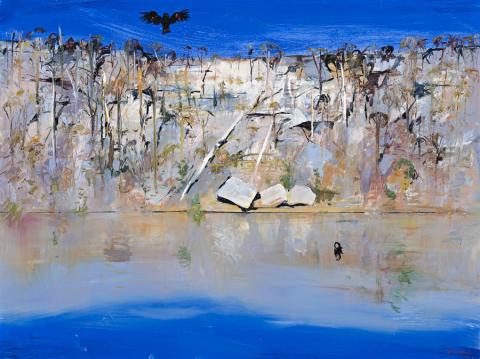SHOALHAVEN WITH BLACK COCKATOO AND SWAN
ARTHUR BOYD
oil on canvas
92.0 x 122.5 cm
signed lower right: Arthur Boyd
Blue Boy Gallery, Melbourne
Private collection, Melbourne
‘... so the still shape of breast and ridge, of scrub-marked slope, of threaded white branches poking through the mix –all this shimmers with untouched untouchables un-glare -and the first thing which comes to me is loveliness and the next's an everywhere mirrored stillness: a bush-covered incline held just as it does its eternal act of arriving, moving through to make us be immortal watchers older than centuries who unearth hill-sides from sky,spear-heads from air, and rock-ledged fringes of deep water from our own minds 'movement.'1 - MARTIN HARRISON, BORN 1949
Reflections of the landscape and its characteristic birdlife are as much the subject of Arthur Boyd's Shoalhaven paintings as the river is itself. As poet Martin Harrison so beautifully evokes in Afternoon, 'an everywhere mirrored stillness' is the next thing to capture the imagination after 'loveliness', when contemplating the natural splendour of a Shoalhaven escarpment reflected in the river below. Boyd often returned to this subject at many different times of the day showing the soft pink/gold sunlight of the early morning or the dark shadowy aspects of twilight. In our painting Shoalhaven with Black Cockatoo and Swan, painted in the early 1980s, Boyd has chosen to show the embankment at high noon on a clear, hot summery day. The sky is a cloudless azure blue and the appearance of soft downy green leaves along the riverbank, suggest late spring or early summer. This delicate sapling growth is reflected in the 'mirrored stillness' below and a solitary black swan drifts across the foreground, absorbed in its plumage. The swan forms an arresting contrast with the black cockatoo whose wings are at full span, powerfully poised above the scene like an omniscient predator. Throughout his Shoalhaven works, Boyd would often turn to the duality in this landscape he came to love so much since purchasing his first property at Riversdale in 1972. For Boyd the Shoalhaven was both a sanctuary and a hostile, rugged territory. He commented once, 'It is a fierce country, subject to violent changes such as floods and intense heat. The actual size of things about the country, the boulders, the actual timber, is just larger. It's very challenging. Of course, you get the marvellous gentle aspects of places like the mild Bundanon pond, with its subtle colours and bird life.'2
1. Harrison, M., Afternoon, (excerpt) poem written in response to Arthur Boyd's The Four Times of Day Afternoon Version II 1983, Newcastle Regional Art Gallery, New South Wales
2. McGrath, S., The Artist and the River - Arthur Boyd and the Shoalhaven, Bay Books, Sydney,1982, p. 40
LARA NICHOLLS
